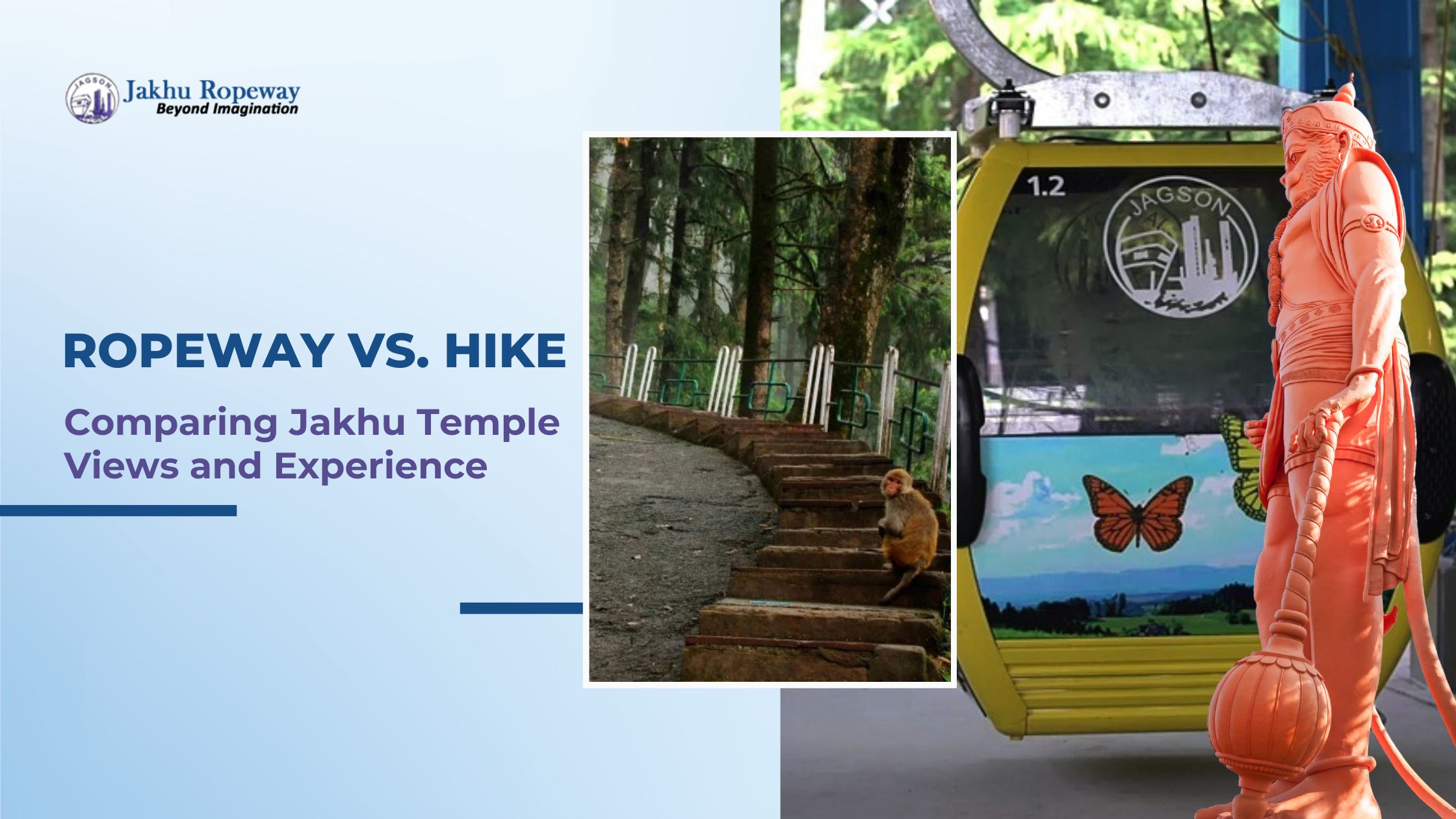
Ropeway vs. Hike: Comparing Jakhu Temple Views and Experience
When visiting the beautiful hill station of Shimla, a trip to Jakhu Temple Shimla is often at the top of every traveller’s itinerary. Nestled at an altitude of about 8,000 feet, this sacred shrine dedicated to Lord Hanuman not only offers spiritual solace but also breathtaking panoramic views. But the question remains: should you trek up or glide over the hills with the Jakhu Ropeway?
Having experienced both—the arduous yet fulfilling Jakhu Temple trek and the thrilling Jakhu Ropeway experience—I can say each has its magic. But if you decide which path to take, this “before and after” breakdown of views, convenience, and overall experience will help you pick the route that suits your spirit.
The Classic Climb: Jakhu Temple Trek
Let’s start with the old-school way—on foot.
The Jakhu Temple trek is around 2.5 km from The Ridge, winding through steep pathways, dense deodar forests, and charming silence broken only by the rustle of leaves and your breath. It’s a moderately challenging trek, especially for those not used to inclines. However, the journey is part of the pilgrimage for nature lovers and fitness enthusiasts.
What You See: Before the Ropeway
The views during the Jakhu Temple trek unfold gradually. As you ascend, Shimla’s colonial rooftops peek through the trees. The higher you go, the more the town unrolls like a toy village below. Occasionally, you’ll see mischievous monkeys playing by the trees or posing for photos. There are resting spots where you can catch your breath and admire the woods.
But here’s the thing—this narrow path can be slippery during rain. There are moments when the trees block panoramic views, and you may be too tired to pause and soak in the landscape. The beauty is in the effort and the subtle glimpses of nature rather than dramatic visual payoffs.
The Modern Lift: Jakhu Ropeway Experience
Now, fast-forward to the modern convenience of the Jakhu Ropeway Shimla. Within 5-6 minutes, the cable car lifts you from the busy Ridge to the temple hilltop, offering the most stunning aerial views Shimla has.
This ropeway connects you directly to the sky above the dense green canopy. You’ll see Mall Road, Lakkar Bazaar, and snow-capped peaks (on clear days) all from your enclosed cabin. The ropeway moves steadily, allowing enough time to soak in the breathtaking scenery without the physical strain.
What You See: After Choosing the Ropeway
The Jakhu Ropeway view is nothing short of cinematic. As you ascend, Shimla unfolds like a 3D model below. Houses resemble colourful Lego blocks and roads like ribbons cutting through the hills. You get a sense of scale—the city nestled among nature, the immensity of the mountains, and how high Jakhu Temple is.
It’s an experience that combines thrill with tranquillity. Children press their faces against the glass. Couples hold hands in awe. It’s not just a means to an end—it’s a ride worth remembering.
Comparing the Views: Jakhu Temple Trek vs Ropeway
Let’s talk specifics:
| Feature | Trek to Jakhu Temple | Jakhu Ropeway Ride |
| Duration | 30–60 mins (one way) | ~6 mins (one way) |
| View Quality | Gradual, obstructed at times | Panoramic, uninterrupted |
| Physical Effort | High – steep path | Low – easy and accessible |
| Ideal For | Adventurers, hikers | Families, elders, children |
| Photography | Few scenic points | Great for wide-angle shots and selfies |
| Weather Impact | Risky in rain/snow | Safer, controlled environment |
Reaching the Temple: The Spiritual Side
Whether you climb or float, the moment you step onto the temple grounds is magical. Standing at 108 feet, the towering Hanuman statue overlooks the valley like a silent guardian. Tall pine trees surround the temple complex, and bells chime softly in the breeze. You can sense a shift—calmness, reverence, peace.
If you’ve trekked, the sense of achievement adds emotional depth to your prayers. If you’ve taken the ropeway, the calm you felt during the ride continues at the hilltop, making the spiritual connection feel lighter and joyful.
Making the Right Choice: Which One Wins?
So, which route wins your heart—Nainital ropeway vs Shimla ropeway, or in this case, trek vs cable?
Here’s how you decide:
- Go for the Jakhu Temple trek if:
- You enjoy hiking or are physically active.
- You want a quieter, nature-immersed journey.
- You’re visiting during a less crowded season (off-peak summer or autumn).
- You seek spiritual accomplishment through physical effort.
- Opt for the Jakhu Ropeway Shimla if:
- You’re with kids or older adults.
- You want to save time or energy.
- You want to capture the best possible views.
- You visit during peak season to avoid heavy foot traffic or traffic jams.
Frankly, both offer distinct views and experiences—one is grounded and raw, the other elevated and cinematic.
Bonus Tip: Why Not Try Both?
Here’s an idea for the adventurous yet comfort-loving traveller—trek one way and take the ropeway the other! Start your day with a fresh morning hike, reaching the temple energized and fulfilled. After soaking in the atmosphere, reward yourself with a relaxing cable car descent back to the hustle and bustle of The Ridge.
This way, you get the best of both worlds: the immersive nature of the Jakhu Temple trek and the unforgettable sights of the Jakhu Ropeway view.
Final Thoughts: A View That Stays With You
Whether you hike the slopes or soar above the trees, reaching Jakhu Temple Shimla is a memory carved deep in the heart. But if you’re a traveller who values the journey as much as the destination, the Jakhu Ropeway experience stands out. It redefines a hill station visit—easy, scenic, and utterly thrilling.
In the battle of Jakhu Temple Trek vs Ropeway, there’s no real loser. It all comes down to what kind of explorer you are. Do you chase the joy of walking through whispering woods or wish to glide with the clouds?
Whichever you choose, Shimla’s crown jewel awaits—its most sacred temple, its tallest view, and a journey that might just become your favourite story to tell.






